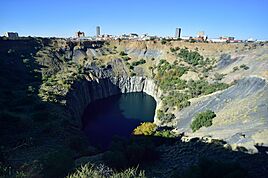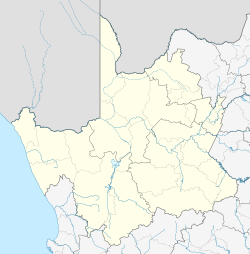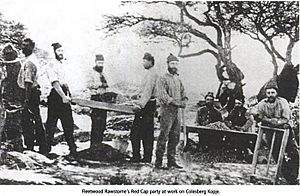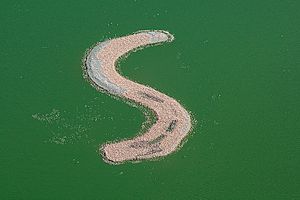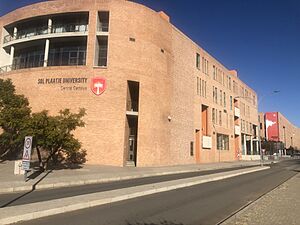Kimberley, Northern Cape facts for kids
Quick facts for kids
Kimberley
|
|
|---|---|
|
Top: City centre seen over the Big Hole, Middle left: Griqualand West High Court, right: Kimberley Town Hall, bottom left: Trinity Church, Honoured Dead Memorial, World War I Memorial
|
|
| Country | |
| Province | |
| District | Frances Baard |
| Municipality | Sol Plaatje |
| Established | 5 July 1873 |
| Area | |
| • Total | 212.64 km2 (82.10 sq mi) |
| Elevation | 1,184 m (3,885 ft) |
| Population
(2011)
|
|
| • Total | 225,160 |
| • Density | 1,058.88/km2 (2,742.48/sq mi) |
| Racial makeup (2011) | |
| • Black African | 63.1% |
| • Coloured | 26.8% |
| • Indian/Asian | 1.2% |
| • White | 8.0% |
| • Other | 0.9% |
| First languages (2011) | |
| • Afrikaans | 43.2% |
| • Tswana | 35.8% |
| • English | 8.7% |
| • Xhosa | 6.0% |
| • Other | 6.3% |
| Time zone | UTC+2 (SAST) |
| Postal code (street) |
8301
|
| PO box |
8300
|
| Area code | 053 |
Kimberley is a major city in South Africa. It is the capital of the Northern Cape province. The city is famous for its history of diamond mining. Many important events happened here, including a big battle during the Second Boer War.
Kimberley was also a pioneer in technology. On September 2, 1882, it became the first city in the Southern Hemisphere to have electric street lights. It was only the second city in the world to do so, after Philadelphia in the United States. Africa's first stock exchange was also built in Kimberley in 1881.
Contents
Discovering Diamonds in Kimberley
How Diamonds Were First Found
In 1866, a boy named Erasmus Jacobs found a shiny pebble near the Orange River. This pebble turned out to be a 21.25-carat diamond, later called the Eureka Diamond. Three years later, an even bigger diamond, the 83.5-carat Star of South Africa, was found nearby. These discoveries sparked a huge diamond rush!
In 1871, a cook named Esau Damoense found diamonds on a small hill called Colesberg Kopje. This led to a "New Rush" as thousands of people rushed to the area. Soon, the hill was dug out and became the famous Kimberley Mine.
Many groups claimed ownership of the diamond fields, including the Cape Colony, Transvaal, Orange Free State, and the Griqua leader Nicolaas Waterboer. After discussions, the land was given to Waterboer, who then asked for British protection. This area became known as Griqualand West in 1871.
How Kimberley Got Its Name
When British officials arrived in 1871, they found the diamond digging area was called "New Rush." The British Secretary of State for the Colonies, John Wodehouse, 1st Earl of Kimberley, didn't like the name "New Rush" or the Dutch name "Vooruitzigt." He wanted a "decent and intelligible" name.
So, on July 5, 1873, New Rush was officially renamed Kimberley in honor of Lord Kimberley. Many diggers felt sad about the change, saying, "we went to sleep in New Rush and waked up in Kimberley, and so our dream was gone."
In 1877, Griqualand West became part of the Cape Colony.
The Big Hole and Other Mines
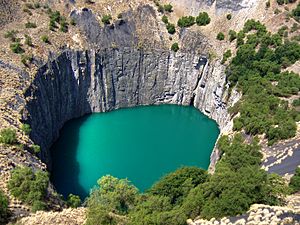
The Big Hole is a massive hole dug by hand. From 1871 to 1914, about 50,000 miners used picks and shovels to dig it. They found 2,722 kilograms of diamonds! The Big Hole is 463 meters wide and was dug to a depth of 240 meters. Today, it has water at the bottom, making it a unique sight.
While the Big Hole is famous, the Jagersfontein Mine actually holds the record for the largest hand-dug hole. Kimberley's mines are so important that they are being considered for a spot on UNESCO's World Heritage list. By 1873, Kimberley was the second-largest town in South Africa, with about 40,000 people.
De Beers and Its Influence
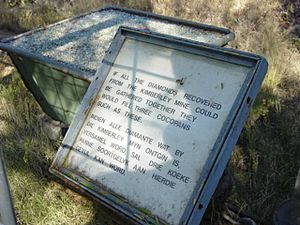
Many smaller mining companies in Kimberley were combined by Cecil Rhodes and Charles Rudd to form De Beers. Later, De Beers merged with another company to create De Beers Consolidated Mines in 1888. For a long time, this company controlled most of the world's diamond market.
Kimberley grew quickly because many people from all over Africa came to work in the mines. De Beers needed a lot of workers. The diamonds were found in special rock called kimberlite, named after the town. Kimberlite is a blue rock found under a yellow layer of soil.
The Big Hole closed in 1914. Three other large mines, Dutoitspan, Wesselton, and Bultfontein, closed in 2005.
The Second Boer War and Kimberley
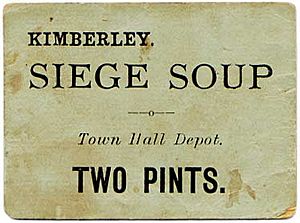
Kimberley faced a difficult time during the Second Boer War. On October 14, 1899, the city was surrounded by Boer forces. This event is known as the Siege of Kimberley. British forces tried to help the city but faced heavy losses. The siege finally ended on February 15, 1900. During the war, the British also built a camp near Kimberley for Boer women and children.
In 1912, the towns of Kimberley and Beaconsfield officially joined together to form the City of Kimberley.
Life Under Apartheid
Apartheid was a system of strict racial segregation in South Africa. It had a big impact on Kimberley. Laws like the Group Areas Act divided communities based on race: White, Black, Coloured, and Indian. Families could even be split up. People were forced to move to different areas, creating new townships on the edges of the city.
This system also affected churches and schools. Some schools were forced to move, and others were closed. Laws restricted the movement of Black Africans, and many public places were only for "Europeans."
People in Kimberley resisted apartheid. In 1952, Dr. Arthur Letele led a group of volunteers to challenge segregation laws by sitting on "Europeans Only" benches at the railway station. This led to arrests. Later that year, the Mayibuye Uprising happened, where people protested poor conditions.
Important anti-apartheid leaders like Robert Sobukwe, who founded the Pan Africanist Congress, lived in Kimberley. He was kept under house arrest here after being released from Robben Island. Frances Baard, a famous trade unionist, was also born in Kimberley.
Kimberley After Apartheid
After apartheid ended in 1994, Kimberley became the capital of the new Northern Cape Province. The city grew as new government departments were set up. The Kimberley City Council was renamed the Sol Plaatje Local Municipality after the famous writer and activist Sol Plaatje, who lived in Kimberley. The district council was named the Frances Baard District Municipality.
With apartheid gone, schools and suburbs that were once only for white people became open to everyone. However, many Black people still live in townships where poverty is common. New housing developments were built to help. A new community called Platfontein was created for the !Xun and Khwe people, who moved there from other areas.
Kimberley's Economy
Kimberley played a huge role in South Africa's early industrial growth. The diamond mines attracted many workers from across the continent. This led to the development of the "compound system," where migrant workers lived in special housing. This system was later used in gold mines too.
Kimberley was home to South Africa's first stock exchange, the Kimberley Royal Stock Exchange, which opened in 1881. In 1882, Kimberley was the first city in the Southern Hemisphere to have electric street lights.
The city also hosted a big exhibition in 1892, showing off art and mining technology. South Africa's first school of mines opened here in 1896. It later moved and became part of the University of the Witwatersrand in Johannesburg.
Transport in Kimberley
Air Travel
Kimberley was home to South Africa's first aviation school in 1913. This school trained pilots for the South African Aviation Corps. Today, you can visit the Pioneers of Aviation Museum near the Kimberley Airport to learn more. The airport has regular flights to Cape Town and Johannesburg.
Rail Travel
Railways reached Kimberley in 1885, connecting it to Cape Town. This made it easier to transport people and goods. The railway network eventually linked Kimberley to other major cities like Port Elizabeth, Johannesburg, and Durban. Today, passenger trains still connect Kimberley to other parts of South Africa, including luxury services like the Blue Train.
Road Travel
In the early days, wagon and coach routes quickly developed to reach the diamond fields. The route through Kimberley became very important for British colonial expansion. Today, Kimberley is located where the N12 and N8 national roads meet.
Kimberley Today
Today, Kimberley is the center of government for the Northern Cape province. It supports the mining and farming industries in the region.
Tourism in Kimberley
Kimberley is a popular tourist spot, known as the "City that Sparkles." It has many museums and attractions. It's also a starting point for exploring other places in the Northern Cape, like the Mokala National Park and historic battlefields.
Hosting Conferences
Kimberley has a large convention center, the Mittah Seperepere Convention Centre. It has hosted important meetings, including the first meeting of the Kimberley Process Certification Scheme in 2000. This scheme helps prevent the trade of "conflict diamonds."
Climate and Geography
Kimberley's Weather
Kimberley has a semi-arid climate, which means it's quite dry. Summers are long and can be wet, while winters are short, mild, and dry with cold nights.
| Climate data for Kimberley (1991–2020, extremes 1877–present) | |||||||||||||
|---|---|---|---|---|---|---|---|---|---|---|---|---|---|
| Month | Jan | Feb | Mar | Apr | May | Jun | Jul | Aug | Sep | Oct | Nov | Dec | Year |
| Record high °C (°F) | 43.3 (109.9) |
43.6 (110.5) |
38.2 (100.8) |
37.5 (99.5) |
31.1 (88.0) |
27.8 (82.0) |
27.2 (81.0) |
31.6 (88.9) |
36.6 (97.9) |
42.3 (108.1) |
39.2 (102.6) |
40.9 (105.6) |
43.6 (110.5) |
| Mean daily maximum °C (°F) | 32.7 (90.9) |
31.9 (89.4) |
28.9 (84.0) |
25.9 (78.6) |
22.6 (72.7) |
19.5 (67.1) |
19.5 (67.1) |
22.2 (72.0) |
26.6 (79.9) |
29.4 (84.9) |
31.0 (87.8) |
32.7 (90.9) |
27.0 (80.6) |
| Daily mean °C (°F) | 25.0 (77.0) |
24.5 (76.1) |
22.3 (72.1) |
18.1 (64.6) |
14.1 (57.4) |
10.7 (51.3) |
10.5 (50.9) |
13.0 (55.4) |
17.2 (63.0) |
20.5 (68.9) |
22.4 (72.3) |
24.3 (75.7) |
18.5 (65.3) |
| Mean daily minimum °C (°F) | 17.3 (63.1) |
17.1 (62.8) |
14.6 (58.3) |
10.2 (50.4) |
5.6 (42.1) |
1.8 (35.2) |
1.4 (34.5) |
3.7 (38.7) |
7.7 (45.9) |
11.6 (52.9) |
13.8 (56.8) |
15.9 (60.6) |
10.0 (50.0) |
| Record low °C (°F) | 5.7 (42.3) |
5.6 (42.1) |
2.0 (35.6) |
−2.8 (27.0) |
−5.7 (21.7) |
−8.4 (16.9) |
−9.9 (14.2) |
−8.5 (16.7) |
−5.5 (22.1) |
−0.7 (30.7) |
2.2 (36.0) |
3.8 (38.8) |
−9.9 (14.2) |
| Average precipitation mm (inches) | 72.9 (2.87) |
67.4 (2.65) |
62.2 (2.45) |
38.6 (1.52) |
15.2 (0.60) |
8.6 (0.34) |
2.6 (0.10) |
3.8 (0.15) |
9.9 (0.39) |
31.1 (1.22) |
39.3 (1.55) |
52.2 (2.06) |
404.3 (15.92) |
| Average precipitation days (≥ 1.0 mm) | 7.1 | 5.9 | 6.1 | 4.4 | 2.1 | 1.0 | 0.6 | 0.8 | 1.1 | 3.6 | 4.7 | 6.3 | 44.0 |
| Average relative humidity (%) | 45 | 53 | 57 | 59 | 54 | 53 | 48 | 41 | 36 | 40 | 42 | 42 | 47 |
| Mean monthly sunshine hours | 291.1 | 244.3 | 268.3 | 262.2 | 270.6 | 263.3 | 278.7 | 296.5 | 274.4 | 295.4 | 301.9 | 313.3 | 3,360 |
| Source 1: NOAA, Deutscher Wetterdienst (June record high, November record low), Meteo Climat (record highs and lows) | |||||||||||||
| Source 2: South African Weather Service | |||||||||||||
| Weather chart for Kimberley | |||||||||||||||||||||||||||||||||||||||||||||||
|---|---|---|---|---|---|---|---|---|---|---|---|---|---|---|---|---|---|---|---|---|---|---|---|---|---|---|---|---|---|---|---|---|---|---|---|---|---|---|---|---|---|---|---|---|---|---|---|
| J | F | M | A | M | J | J | A | S | O | N | D | ||||||||||||||||||||||||||||||||||||
|
57
33
18
|
76
31
17
|
65
29
15
|
49
25
11
|
16
21
7
|
7
18
3
|
7
19
3
|
7
21
5
|
12
26
9
|
30
28
12
|
42
30
15
|
46
32
17
|
||||||||||||||||||||||||||||||||||||
| temperatures in °C precipitation totals in mm source: SAWS |
|||||||||||||||||||||||||||||||||||||||||||||||
|
Imperial conversion
|
|||||||||||||||||||||||||||||||||||||||||||||||
Water Supply
Kimberley gets its water from the Vaal River. The water is pumped from Riverton, which is about 15 kilometers north of the city.
City Areas and Population
Kimberley has many different neighborhoods and townships. According to the 2011 census, the city of Kimberley itself had about 97,000 people. The nearby townships of Galeshewe and Roodepan had about 108,000 and 20,000 people, respectively. This means the total population of the urban area was around 225,000.
Most people in Kimberley are "Black African" (63.1%), followed by "Coloured" (26.8%), "White" (8.0%), and "Indian or Asian" (1.2%). The most common languages spoken are Afrikaans (43.2%) and Tswana (35.8%).
Natural Landscape
Kimberley is mostly flat. The only "hills" are actually piles of rock and soil left over from more than a century of diamond mining. Some of these mine dumps near the Big Hole are now protected as historical sites.
Just outside the city, the landscape is also flat, with some small hills and shallow pans.
One special place near Kimberley is Kamfers Dam. This large pan north of the city is an important wetland. It's home to a breeding colony of lesser flamingos. Efforts are made to protect this area and its wildlife.
Education in Kimberley
Education is a very important part of life in Kimberley.
Primary Schools
- Kimberley Junior School
- St Cyprian's Grammar School
Secondary Schools
- Adamantia High School
- Diamantveld High School
- Floors High School
- Greenpoint High School
- Homevale Secondary High School
- HTS Kimberley
- Kimberley Boys' High School
- Kimberley Girls' High School
- Northern Cape High School
- St. Boniface High School
- Christian Brothers College
- William Pescod High School
Universities and Colleges
- Qualitas Career Academy: A private college offering full-time and part-time studies.
Sol Plaatje University
The Sol Plaatje University opened in Kimberley in 2014. It was named after the famous writer and activist Sol Plaatje. The university focuses on unique subjects like heritage studies, museum management, and indigenous languages, which are important to the history of Kimberley and the Northern Cape.
Society and Culture
Religions in Kimberley
Kimberley has always been a place where people of many different faiths live together. Today, you can find churches for various Christian groups, mosques for Muslims, synagogues for Jewish people, and temples for Hindus. Traditional African beliefs are also practiced. Kimberley is an important center for the Anglican and Roman Catholic churches.
Arts, Music, and Literature
Many talented artists have come from Kimberley, including William M. Timlin and Walter Westbrook. Writers with strong links to the city include Sol Plaatje, who wrote Mhudi, and Olive Schreiner. Dr Victor is a well-known reggae and R&B musician from Kimberley.
Museums, Monuments, and Memorials
Kimberley is rich in history, with many places to visit:
- The Big Hole: This museum and recreated town shows what life was like during the diamond rush.
- The McGregor Museum: This museum has large collections about the history and environment of the Northern Cape.
- The William Humphreys Art Gallery: A place to see beautiful art.
- The Kimberley Africana Library: A library with historical documents and books.
- Pioneers of Aviation Museum: Learn about South Africa's first flying school, which opened in Kimberley in 1913.
- The Sol Plaatje Museum: Located in the house where Sol Plaatje lived and wrote.
- A heritage tramway: You can ride one of Kimberley's old trams.
- Wildebeest Kuil Rock Art Centre: See ancient rock art on the outskirts of the city.
- Magersfontein Battlefield Museum: Learn about a famous battle from the Second Boer War.
There are also many memorials:
- The Miners' Memorial: Honors all the miners of Kimberley.
- The Honoured Dead Memorial: Remembers those who died defending Kimberley during the Siege of Kimberley.
- The Cenotaph: Commemorates soldiers who died in World War I and II.
- The Concentration Camp Memorial: Remembers those held in the Kimberley concentration camp during the Second Boer War.
- The Henrietta Stockdale statue: Honors a nurse who helped make nursing a recognized profession.
- The Frances Baard statue: Honors the trade unionist born in Kimberley.
- The Sol Plaatje Statue: Honors the famous writer and activist.
Architecture
Kimberley has many interesting buildings, some of which are heritage sites:
- Alexander McGregor Memorial Museum (1907)
- Kimberley City Hall (Neo-classical style)
- Kimberley Club
- Old School of Mines
- Rudd House
Important Religious Buildings
- Dutch Reformed Mother Church Newton: A beautiful church with unique stucco architecture.
- Kimberley Seventh-day Adventist Church: Considered the first Seventh-day Adventist church in South Africa.
- St Cyprian's Anglican Cathedral: A large cathedral with beautiful stained glass windows.
- St Mary's Roman Catholic Cathedral.
- Synagogue: Designed in the Byzantine style, similar to a synagogue in Florence, Italy.
Media
Newspapers
The first newspaper in Kimberley was the Diamond Field in 1870. Today, Kimberley's daily newspaper is the Diamond Fields Advertiser, published since 1878. Afrikaans readers can read Volksblad with a local supplement called Noordkaap.
Radio
Kimberley has two community radio stations:
- Radio Teemaneng
- XKfm: This station broadcasts from Platfontein in the !Xun and Khwe languages.
Sports in Kimberley
Cricket
Kimberley has produced several international cricket players, including Xen Balaskas and Pat Symcox. The city also hosted a match during the 2003 ICC Cricket World Cup.
Rugby
Kimberley is home to the Griquas rugby team, which has won the Currie Cup three times. Famous rugby players like Ian Kirkpatrick and Tommy Bedford have played here.
Football
South African footballers Richard Henyekane and Jimmy Tau are from Kimberley.
Swimming
Karen Muir, born in Kimberley, became the youngest person ever to break a world record in any sport in 1965, at just 12 years old. She set a record in the 110-meter backstroke. The municipal swimming pool in Kimberley is named after her.
Athletics
Bevil Rudd, an Olympic medalist, is from Kimberley.
Skateboarding
Kimberley has hosted major international skateboarding events, including the first Maloof Money Cup World Skateboarding Championships in 2011. The event later became known as the Kimberley Diamond Cup.
Sporting Facilities
- Griqua Park
- De Beers Diamond Oval
- Galeshewe Stadium
Interesting Facts and Quotes
- The Kimberley Process Certification Scheme (KPCS) was created in Kimberley in 2000. It helps stop the trade of "conflict diamonds," which are used to fund wars.
- The Kimberley Declaration is a statement from 2002 about respecting and protecting traditional knowledge.


